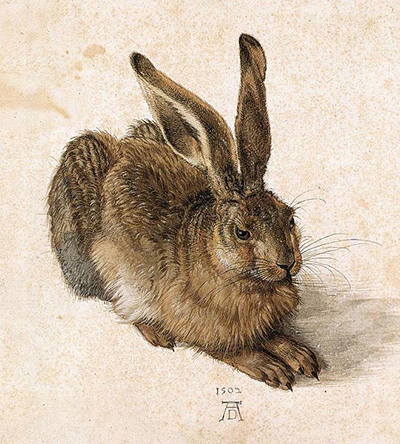This study of a wild hare is surely one of Albrecht Dürer’s most popular works. For many people who like and admire it, it may be the first of Dürer’s masterpieces that they ever encounter, or the first time they connect a work with his name.
It has appeared in world encyclopaedias of art, but also on greeting cards and diaries in museum gift shops around the globe. Perhaps it’s time to look again at such a simple and masterfully evoked subject.
The identification of much of Dürer’s early work, from his years of travel and apprenticeship, is the subject of debates that may never be resolved. Art historians have tried to discern traits of the maturing Dürer style in many of the woodcut series produced at the end of the 15th century; a time when illustrated books were still rapidly growing in popularity, but when an author was more likely to be credited than the artist of the accompanying illustrations.
The characteristic style - the one that becomes unmistakably his - is a combination of superb skill and a sense of detail.
This virtuoso technique and subtlety of observation can be used to create a vivid intensity of action – the frames of the 15 Apocalypse images, for example, can hardly contain the fulfilment of the end of days. However, the young hare – painted around five years later – shows the same qualities used to a totally different effect.
From mighty events on a cosmic scale, we have a single figure without a background, and a perfectly captured moment of stillness and alertness. A sound or a slight change in the wind, and the head will tilt or the ears twitch, and the hare will have gone.
Even before he encountered Leonardo da Vinci’s work, Dürer approached the natural world in a similar way. Among his incomparably diverse studies, da Vinci prepared detailed illustrations of human anatomy, but also botanical sketches and drawings from nature.
It is impossible to be sure how Dürer completed his study of the hare, and whether he worked from a dead specimen or sketched certain impressions or details from life – though the German title, literally “The Field-Hare”, seems to offer a tantalising clue. Whatever the technique, he created a masterpiece of observation – from the variations in colour in the animal’s pelt, to the natural liveliness of ears and eye.
British art critics have sometimes drawn comparisons with later artists such as Stubbs and Landseer for their realism and affinity of subject. However, Dürer’s work seems to later eyes to have an almost scientific appreciation of the hare.
In any case, his monogram suggests that he considered this a finished and valued work, rather than merely a preparation for a later painting. An earlier study generally known as “The Great Piece of Turf” or “Das große Rasenstück” – often compared with the hare – is more typical of this latter approach. But even here, Dürer is meticulous: botanists have identified at least four particular species of plant or grass in the picture.
Dürer worked in an age when religious symbolism still dominated everything from folk-art to state ceremonials. Few artists would have depicted any animal without a familiar system of allegorical cross-references. Dürer’s hare can be simply itself – and that may be part of its enduring popularity.




